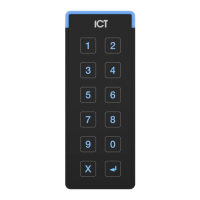A 330 ohm EOL (End of Line) resistor may be required to be inserted between the NA and NB terminals of the
reader and a second 330 ohm EOL resistor must then be inserted between the source NA and NB terminals at
the other end of the wiring.
OSDP Reader Connection
OSDP reader mode is only available for tSec Readers with firmware version 1.04.267 or higher. Readers that
only support 125kHz reading and readers with PSK hardware do not support OSDP.
Connecting a tSec Reader in OSDP mode is the same as the connection for standard RS-485 configuration.
Shield is frame
grounded at
one point
Shielded Cable
RED
BLACK
GREEN
WHITE
ORANGE
BROWN
BLUE
YELLOW
VIOLET
Shield not
connected
SHIELD
1 2
3 4
5 6
7 8
9 0
X
V+
V-C BZ L2 L1
D1/ D0/
NB
NA
Readers must also be programmed to operate in OSDP mode. For more information, see Programming the
Card Reader (next page).
For more information about OSDP support on tSec Readers, including configuring readers for secure channel
communications, see Application Note 321: Configuring tSec Multi-Technology Card Readers for OSDP
Communication.
OSDPBaud Rate Requirement
For a tSec Reader operating in OSDPmode to communicate with an OSDP Server, it must have the same baud
rate as the reader port it is connected to.
⦁ The default tSec Reader baud rate is 38400
⦁ The typical default reader port baud rate is 9600
The tSec Reader baud rate can be programmed using:
⦁ A mobile device running the Protege Config App
⦁ A correctly encoded MIFAREconfig card
A suitably configured MIFARE config card can be ordered from the ICT customer services team.
To program the reader using the ConfigApp select the Uart Configuration TLV and set the Baud to 9600.
For detailed information on programming tSec Readers, refer to AN-283: Programming tSec Reader Functions.
PRX-TSEC Range | tSec Multi-Technology Card Reader with Bluetooth® Technology | Installation Manual 17

